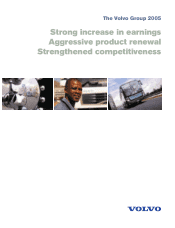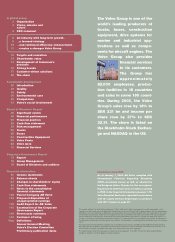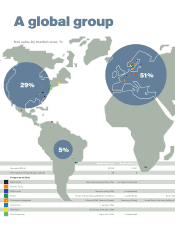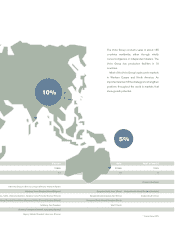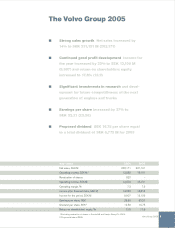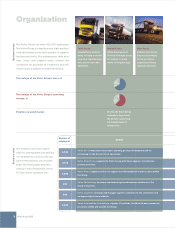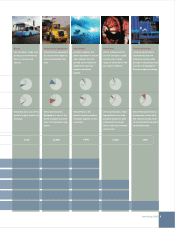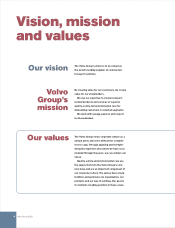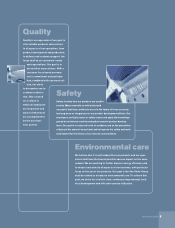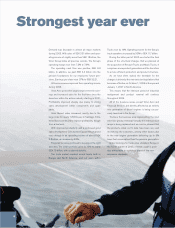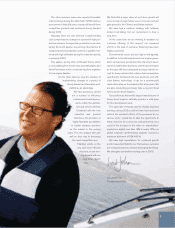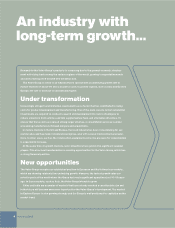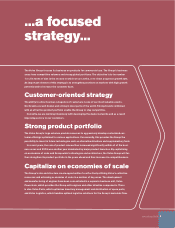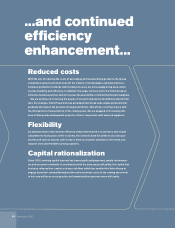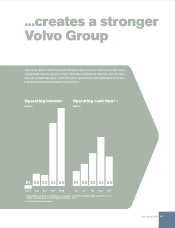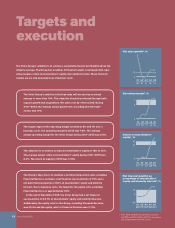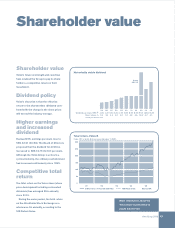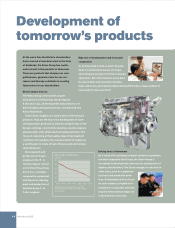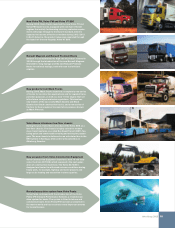Volvo 2005 Annual Report Download - page 10
Download and view the complete annual report
Please find page 10 of the 2005 Volvo annual report below. You can navigate through the pages in the report by either clicking on the pages listed below, or by using the keyword search tool below to find specific information within the annual report.
Strongest year ever
Demand was favorable in almost all major markets
during 2005. With sales of SEK 231 billion and oper-
ating income of slightly more than SEK 18 billion, the
Volvo Group broke all previous records. The Group’s
operating margin rose from 7.3% to 7.9%.
The operating cash flow was positive, SEK 6.8
billion. In addition, we paid SEK 4.4 billion into the
pension foundations for our employees’ future pen-
sions. Earnings per share rose 37% to SEK 32.21.
All business areas improved their operating income
during 2005.
Volvo Aero posted the largest improvement in earn-
ings and increased sales for the first time since the
downturn within the airline industry starting in 2001.
Profitability improved sharply, due mainly to strong
sales development within components and spare
parts.
Volvo Buses’ sales increased, mostly due to the
large order for nearly 1,800 buses to Santiago, Chile.
Volvo Buses continued to improve profitability, though
from a low level.
With improved productivity and a continued good
sales development, Construction Equipment advanced
very strongly to an operating income of almost SEK
2.8 billion, an increase by 45%.
Financial Services continued to develop in the right
direction. The credit portfolio grew by 10% to nearly
SEK 79 billion, with sustained stability.
The truck market reached record levels, both in
Europe and North America, and our sales within
Trucks rose by 14%. Operating income for the Group’s
truck operations increased by 30% to SEK 11.7 billion.
During the latter part of 2005 we started the final
phase of the structural changes that we planned at
the acquisition of Renault Trucks and Mack Trucks. It
comprises a new produ c t generation and the transition
to a more efficient production and product structure.
As we have often stated, the timetable for the
changes is driven by the new emission legislations that
becomes effective on October 1, 2006 in Europe and
January 1, 2007 in North America.
This means that the intensive period of industrial
realignment and product renewal will continue
throughout 2006.
All of the business areas, except Volvo Aero and
Financial Services, are directly affected as an entirely
new generation of diesel engines is being succes-
sively launched in the Group.
Trucks is the business area implementing the most
extensive product renewal. Virtually the entire product
range is being replaced and we can be pleased that
the products rolled out to date have been very well
received by the customers, among other factors due
to the new engine generation delivering up to 5%
lower fuel consumption than the previous generation.
Order bookings for trucks rose sharply in Europe in
the fourth quarter of 2005, of which a part is prob-
ably attributable to a pre-buy ahead of the new
emissions standards.
6

